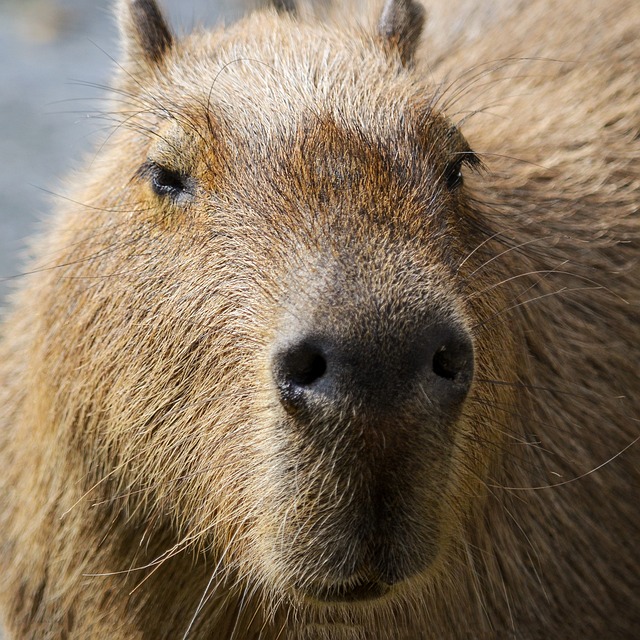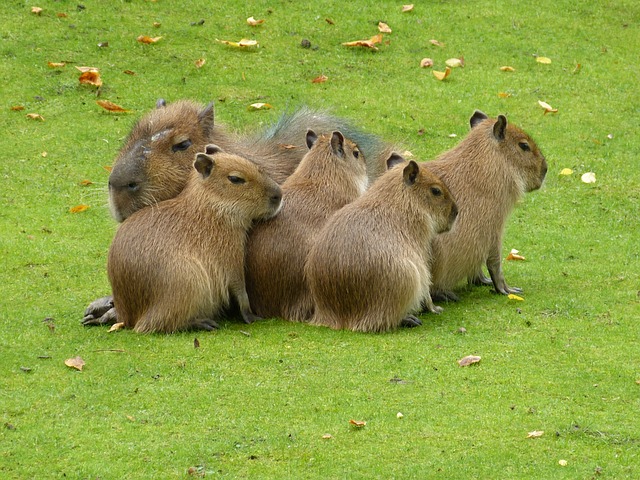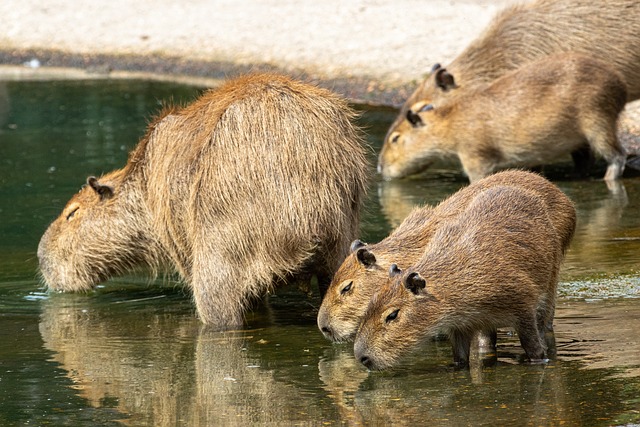Welcome to the world of the capybara – the largest rodent on the planet. With its endearing appearance and fascinating behaviors, the capybara has captured the curiosity and hearts of many in recent years. In this article, we will take an in-depth look at this remarkable creature, exploring its physical characteristics, habitat, social behaviors, diet, reproduction, and its relationship with humans.
From its unique adaptations to its important role in the ecosystem, there is much to discover about the capybara.
The World’s Largest Rodent: Weighing up to 140 pounds and reaching lengths of over 4 feet, the capybara holds the title of the largest rodent in the world. But there is more to this gentle giant than just its size. Let’s delve deeper into the world of the capybara and learn about its captivating features and behaviors.
The Aim of this Article: Our aim is to provide an in-depth look at the capybara, shedding light on its lesser-known aspects and highlighting the reasons for its growing popularity. So, let’s embark on this journey and discover the wonders of the world’s largest rodent.
Table of Contents
Physical Characteristics of the Capybara
The capybara, also known as the “water pig,” is a fascinating creature that has captured the interest of many in recent years. As the largest rodent in the world, it is no surprise that people are curious to learn more about this unique animal. In this section, we will take an in-depth look at the physical characteristics of the capybara and how they contribute to its survival in the wild.

Size and Weight:
One of the most notable features of the capybara is its impressive size. On average, an adult capybara can weigh between 35 to 66 kilograms and reach a length of up to 1.3 meters. This makes them larger than many other well-known rodents such as beavers and porcupines. As herbivores, they need to consume large amounts of vegetation to sustain their size and weight.
Unique Physical Features:
The capybara has several unique physical features that set it apart from other rodents. One of the most notable is its webbed feet, which are perfectly adapted for its semi-aquatic lifestyle. These webbed feet allow the capybara to move swiftly through the water, making it a strong swimmer. Additionally, the capybara has a barrel-shaped body, which helps to distribute its weight evenly and allows it to navigate through dense vegetation. They also have a short, round tail, which is used for communication and balance while swimming.
Adaptations:
The capybara’s physical features are well adapted to its natural habitat, which is primarily found in South America. The webbed feet help them to navigate through the water with ease, while their barrel-shaped body makes it easier for them to move through dense vegetation. They also have eyes and nostrils positioned on the top of their heads, allowing them to see and breathe while partially submerged in the water. This is a crucial adaptation for their survival as they are often hunted by predators such as jaguars and anacondas.
Habitat and Distribution:
Capybaras are primarily found in South America, where they inhabit a variety of ecosystems such as wetlands, grasslands, and forests. They are highly adaptable and can thrive in various types of environments, as long as there is water nearby. However, their distribution is limited to these regions due to their specific habitat requirements. As humans continue to encroach on their land for agriculture and urbanization, their population and habitat become increasingly threatened.
Intriguingly Social Nature:
While capybaras may be large in size, they are highly social animals. They are known for living in large groups, typically composed of 10 to 20 individuals. These groups are called “herds” and are led by a dominant male. The social nature of capybaras is vital for their survival as it provides protection from predators and helps with resource sharing. They communicate with each other using vocalizations, scent marking, and body language. These complex forms of communication play a crucial role in maintaining social order within the herd.
In conclusion, the physical characteristics of the capybara are essential for its survival in the wild. Its size, unique features, and adaptations all contribute to its ability to thrive in its natural habitat. As we continue to learn more about these fascinating creatures, it is essential to also understand the importance of preserving their habitat and protecting their species for future generations to admire and learn from.
Habitat and Distribution
The capybara is a semi-aquatic mammal that is primarily found in the tropical regions of South America. It is the largest rodent in the world, weighing up to 150 pounds and measuring up to four feet in length. Due to its impressive size, the capybara has earned the nickname “water pig” or “giant guinea pig.”
While capybaras can be found in various parts of South America, they are most commonly spotted in countries such as Brazil, Venezuela, Colombia, and Argentina. They typically inhabit areas with a high abundance of water, such as wetlands, rivers, and lakes. This is because capybaras are excellent swimmers and spend a significant amount of time in the water to regulate their body temperature and avoid predators.
One of the most fascinating aspects of the capybara’s habitat is its ability to adapt to different types of ecosystems. These creatures are highly versatile and can be found in a variety of landscapes, including grasslands, forests, and even human-made habitats like agricultural fields and urban areas. This adaptability has allowed capybaras to thrive in different environments and expand their distribution.
However, despite their adaptability, capybaras have a limited distribution in the wild. This is due to various factors such as habitat destruction, hunting, and competition with other species. As humans continue to encroach upon their habitat, capybaras are facing a decline in population and are listed as a species of least concern on the IUCN Red List.
In their natural habitat, capybaras are social animals and are often found in large groups of up to 20 individuals. These groups, known as herds, are led by a dominant male who is responsible for protecting the group and mating with the females. Within the herd, each member has a specific role, such as guarding the group while others are foraging for food.
The capybara’s habitat also plays a significant role in their survival and well-being. In addition to providing a source of food and water, the diverse ecosystems in which they live also offer protection from predators. Capybaras use their excellent sense of smell and hearing to detect potential threats, and they are quick to take refuge in the water if necessary.
Furthermore, capybaras have also developed specific adaptations that help them thrive in their habitat. One of the most notable is their webbed feet, which allow them to swim with ease and navigate through the water. They also have a thick, waterproof coat that helps regulate their body temperature and protects them from the sun’s rays.
In conclusion, the capybara’s habitat and distribution play a crucial role in their survival and well-being. These fascinating creatures have managed to adapt to various ecosystems, but they are facing threats from human activities. It is essential to conserve their natural habitat and protect their populations to ensure that future generations can continue to marvel at the world’s largest rodent.

Social Behavior and Communication
Capybaras are highly social animals and are known for living in large groups. This is because they are prey animals and being in a group provides them with protection against predators. They can be found in groups of up to 20 individuals, consisting of both males and females. These groups are often seen resting together, grooming each other, and foraging for food. In fact, capybaras are so social that they have even been known to form strong bonds with other species, such as birds and even humans.
Communication is key for capybaras to maintain their social structure and ensure the survival of their group. They have a variety of ways to communicate with each other, including vocalizations, scent marking, and body language.
Vocalizations play a crucial role in capybara communication. They have a wide range of calls, from high-pitched whistles to low grunts. These vocalizations are used to express different emotions and needs, such as alarm calls to warn others of danger or contact calls to locate each other.
Scent marking is also an important form of communication for capybaras. They have scent glands on their noses and around their anus which they use to mark their territory. This helps to establish boundaries between different capybara groups and also serves as a way to attract potential mates.
Body language is another crucial aspect of capybara communication. They use various body postures and movements to convey messages, such as showing dominance or submission. For example, a capybara will lower its head and flatten its ears to show submission to a dominant individual, while raising its head and bristling its fur to show dominance.
Social interactions among capybaras are not just about communication, but also play a vital role in their overall well-being. These interactions help to strengthen bonds within the group and maintain social hierarchy. Grooming, in particular, is an important social behavior that helps to remove parasites and strengthen relationships between individuals.
In addition to communication and social behaviors within their own species, capybaras also have unique interactions with other animals. For example, they have been observed forming symbiotic relationships with birds, as the birds eat insects from the capybara’s fur and in return, the capybara is protected from parasites. They have also been known to interact with humans, and in some communities, capybaras are even considered sacred animals.
However, despite their social nature, capybaras can also exhibit aggressive behavior towards each other, especially during the breeding season when competition for mates is high. This is why having a large social group is important for capybaras as it helps to diffuse any potential conflicts and maintain a peaceful coexistence.
In conclusion, social behavior and communication are crucial aspects of capybara life. Their highly social nature and unique ways of communication allow them to thrive in their natural habitat and maintain strong bonds within their groups. Through their interactions, capybaras demonstrate their intelligence and complex social dynamics, making them truly fascinating creatures to study and observe.
Diet and Feeding Habits
The capybara, being a herbivore, has a very particular diet that is crucial to its survival. These large rodents primarily feed on grass and aquatic plants, making them essential for maintaining the balance of their ecosystem. In this section, we will delve into the specifics of the capybara’s diet and feeding habits, highlighting their unique digestive system and the role they play in their environment.
Herbivorous Diet:
The capybara’s diet is mainly composed of vegetation, with grass being their primary food source. They also consume a variety of aquatic plants, such as water hyacinth, water lettuce, and duckweed. This diet is essential for their survival, as these plants provide them with the necessary nutrients and energy. Interestingly, capybaras have a specialized digestive system that allows them to consume large amounts of food in a short period. This is because they are hindgut fermenters, meaning they have an enlarged cecum that helps break down tough plant fibers.
Unique Digestive System:
Capybaras have a complex digestive system that enables them to efficiently digest their plant-based diet. Their stomach has three chambers, including the rumen, reticulum, and omasum, which are responsible for breaking down the food. After fermentation in the cecum, the digested food moves on to the colon, where water absorption takes place. This process helps them conserve water, as they live in areas with limited water resources. The capybara’s unique digestive system allows them to process large amounts of food quickly, making them essential for maintaining the balance of their ecosystem.
Role in Ecosystem:
As primary herbivores, capybaras play a crucial role in their ecosystem. By consuming vast amounts of vegetation, they help control the growth of plant species, preventing overgrowth and imbalance in the ecosystem. Additionally, their waste products serve as fertilizers, promoting the growth of new plants. This symbiotic relationship between capybaras and plants highlights their significance in the ecosystem.
Feeding Habits:
Capybaras are crepuscular animals, meaning they are most active during dawn and dusk. They spend a significant portion of their day foraging for food, often venturing out to nearby water bodies to feed on aquatic plants. Due to their social nature, they often graze in groups, making it easier for them to find food and ensure their safety from predators. In areas with a high population of capybaras, they can create grazing lawns, which serve as a reliable food source for other herbivores.
Conclusion:
The capybara’s herbivorous diet and unique digestive system are essential for their survival and the balance of their ecosystem. By consuming large amounts of vegetation and acting as primary herbivores, they play a crucial role in maintaining the health and diversity of their habitat. As humans continue to encroach on their natural habitat, it is crucial to protect these fascinating creatures and ensure their survival in the wild.

Reproduction and Offspring
Capybaras are social animals, and their breeding habits are closely linked to their social structure. Breeding season for capybaras usually occurs during the rainy season, which varies depending on the region they inhabit. In areas like Venezuela and Colombia, breeding can happen throughout the year due to the year-round rainfall.
During the breeding season, male capybaras become more aggressive and territorial as they compete for the attention of females. They will often engage in vocalizations and scent marking to mark their territory and attract potential mates. Female capybaras also play a role in the selection process, and they will choose the strongest and most dominant males to sire their offspring.
Once a female capybara is pregnant, the gestation period can last for around five months. The size of a typical litter can range from one to eight pups, with an average of four. The mother will give birth in the water, and the newborn pups will instinctively swim to the surface to take their first breath. They are born with a full set of teeth and are immediately able to swim and walk.
Capybara pups are incredibly vulnerable in their first few weeks of life, and they rely on their mother and the rest of the colony for protection and nourishment. Both parents and other members of the colony play an essential role in the upbringing of the offspring. They will help groom and protect the young, and even allow the pups to nurse from other lactating females within the group.
The strong social bonds within capybara groups are crucial for the survival of the offspring. In the wild, capybaras have a high mortality rate, and communal care helps to ensure the survival of the species. The young capybaras will stay with their parents and the rest of the colony for up to a year before they reach maturity and venture off to find their own territory and start their own families.
As social animals, capybaras also practice alloparenting, where individuals in the group will help care for the offspring of other members. This behavior has been observed in both wild and captive capybaras and is a testament to the strong social bonds within their groups.
Unfortunately, due to habitat destruction and hunting, the capybara population is declining in some regions. In response, conservation efforts have been implemented to protect these gentle creatures. These efforts include limiting hunting and preserving wetlands and other habitats that capybaras depend on for survival.
In recent years, there has also been a growing trend of keeping capybaras as pets. However, this can be challenging as they require a large amount of space and specialized care. In some areas, it is illegal to keep capybaras as pets, and it is essential to research and understand the laws and regulations in your area before considering keeping one as a pet.
In conclusion, capybaras are fascinating creatures with a complex social structure and unique breeding habits. Their strong social bonds and communal care have played a crucial role in their survival and have made them a beloved species among animal lovers. By understanding and protecting the capybara’s reproductive and parenting behaviors, we can help ensure the continued existence of this incredible species.
Human-Capybara Relationship
The relationship between humans and capybaras has a long history. In the past, capybaras were hunted for their meat and fur, leading to a decline in their population. However, in recent years there has been a shift towards the conservation of these fascinating creatures.
Efforts to protect the capybara’s natural habitat and population have been implemented, including the creation of protected areas and laws against hunting them. This has led to a resurgence in their numbers and a better understanding of their ecological importance.
In addition, there is a growing trend of keeping capybaras as pets. While they may seem like cute and cuddly companions, they are complex animals that require specialized care and a suitable environment to thrive. It is important for potential owners to do thorough research and be prepared for the challenges of owning a capybara.
Overall, the human-capybara relationship is evolving towards a more positive and responsible one, with a focus on conservation and responsible pet ownership.
